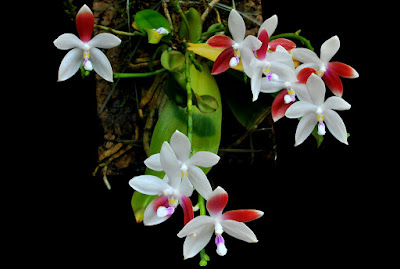Phalaenopsis tetraspis is endemic to the Andaman Islands, the Nicobar Islands and northwestern Sumatra. Its natural habitat is the wet and warm woods at an altitude of 0 - 100 meters...
Phalaenopsis tetraspis also called as The Four Shield Phalaenopsis, Phalaenopsis barrti, Phalaenopsis imperati, Phalaenopsis speciosa var tetraspis, Phalaenopsis sumatrana var alba, Polychilos speciosa, is a species of the genus Phalaenopsis. This species was described by Heinrich Gustav Reichenbach in 1868.
IDENTIFY PHALAENOPSIS TETRASPIS
Phalaenopsis tetraspis is endemic to the Andaman Islands, the Nicobar Islands and northwestern Sumatra. Its natural habitat is the wet and warm woods at an altitude of 0 - 100 meters.
It is a medium sized, hot growing epiphyte with a short stem carrying obovate, shortly acute to obtuse, gradually narrowing below to the basally clasping, 30 cm long leaves.
The Four Shield Phalaenopsis blooms in spring on an arching, lateral, 30 cm long, racemose or paniculate, many flowered inflorescence with a fractiflex rachis that is longer than the leaves with small triangular, concave floral bracts and 4 to 8, fleshy, glossy, fragrant flowers.
PHALAENOPSIS TETRASPIS CARE AND CULTURE
Cultural information should only be used as a guide, and should be to be adapted to suit you. Your physical location; where you grow your plants, how much time you have to devote to their care, and many other factors, will need to be taken into account. Only then can you decide on the cultural methods that best suit you and your plants.
Light:
Phalaenopsis tetraspis needs a light level of 18000-22000 lux. The direct rays of the sun must be shielded. The minimum photoperiod is 12 hours.
Temperature:
The temperatures throughout the year must be 22-28 ° C during the day and 18-22 ° C at night. To promote flowering, daily changes of 3-4 ° C between day and night must be present.
Humidity:
If the orchid is grown in pots, the humidity should be 55-60%. If instead it is placed at bare root, the minimum is 70%.
Substrate, growing media and repotting:
Phalaenopsis tetraspis is grown both in pots and in bare root. The vase to be chosen must be transparent, because this allows to check the conditions of the substrate and roots. Medium-sized pine bark (2-4 cm) is used as a substrate. If the orchid is placed on a raft, it is important to put a layer of sphagnum under its roots to ensure a moisture reserve.
Watering:
The cultivated plant gets water when the substratum is almost dry. It is easy to understand when this moment arrives: the roots of the orchid (if they are not covered with algae) inside the vase take on the silver-green color, while being wet they have a bright green or dark green color. The bare-root orchid gets water every day in the morning; in hot weather it also needs a lot of spraying in the afternoon. Care must be taken to allow the plant to dry before evening. Very often, after a watering, excess water accumulates between the leaves or in the center of the stem. It is important to remove them quickly, because they can cause rottenness.
Fertilizer:
This species is fertilized every 3 watering. 1/2 of the dose indicated on the bottle of a suitable liquid fertilizer for orchids is used. Before fertilizing the plant it is necessary to water it to avoid the harmful effect of the fertilizer on the dry roots.
Rest period:
Phalaenopsis tetraspis does not need any rest to flower. The blooms are stimulated by sudden changes in temperature between day and night and by adequate light and water.















COMMENTS